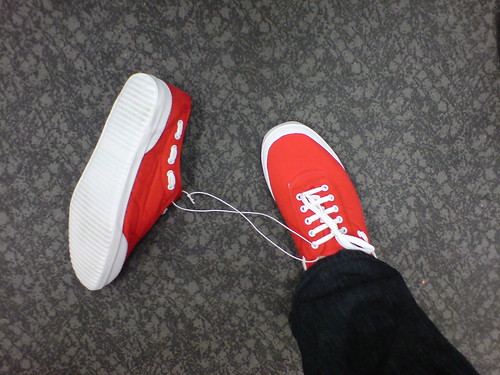
It's extremely annoying that my day job has taken up so much of my time that I rarely get to blog about things when I first notice them. I've been meaning to write about the hipster plimsoll since at least August, and it's been on my radar for far longer. You know the look I'm talking about - skinny jeans on both men and women, with these dainty little canvas sneakers - usually in snowy white (or, more commonly, in scungy white).
The term plimsoll is British - I first remember encountering it in a picture story book about a street football match between neighbourhood children, where one character laments that he could have performed better if he hadn't forgotten his plimsolls. (If anyone can tell me the name of this book, I'd be very pleased.) The shoe was invented as beachwear, and is better known in Australia as a 'sandshoe'. Hilariously, I've discovered a British dotcom called White Plimsolls: "Purveyors of the finest white canvas plimsolls delivered directly to your door. An essential fashion items (sic), worn by style warriors, indie kids, emo-s (sic) and haircuts." Haircuts! ha! ha! ha! I love how they nail their target market.

The trend has been to wear them with short skinny jeans and no socks, so you'll see these hipsters' bony little ankles. Even through bitterest winter. Chicks can also wear them with tights or with bare legs and a skirt, in the manner of Mischa Barton, who popularised this look in 2005 when she became spokesmodel for Keds, a formerly old and daggy shoe company established in 1916. I always associated Keds with old-school hip-hop, but they're better known for these preppy shoes - they do a range of ballet flats as well. Another variation on the trend is to wear the sneakers without laces - as Mischa obligingly demonstrates:

Price-wise, these shoes are at the absolute bottom end of the market - at $60, Keds are massively marked up for what they are. I'm well aware of the unethical reasons why such shoes are so cheap; I'm picturing teenagers in Chinese factories sewing and gluing them together. Still, I don't want to get into an ethical debate specific to these sneakers, because with rare exceptions, hipsters don't care about ethics.
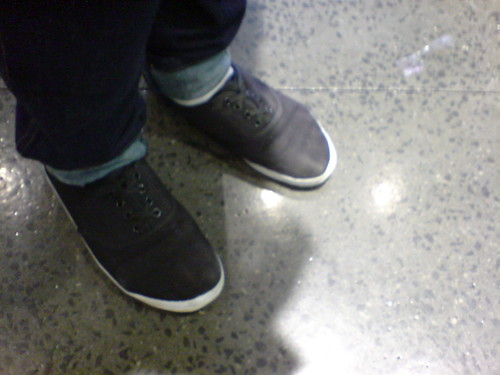
So what do they care about? In early September, I discussed hipster plimsolls with Tait (above). (Customary apologies for the shaky hands.) Tait bought these ones from an Asian import store on Smith Street, Fitzroy. I forget how much they cost, but it's significantly less than the plimsolls at Welcome To Alphaville; Tait alleged that Alex from Alpha60 buys the shoes from the same import store he did, and marks them up for sale at Alphaville.
"No, I didn't buy them from Big W like everyone else," said Tait, "but these are better quality."
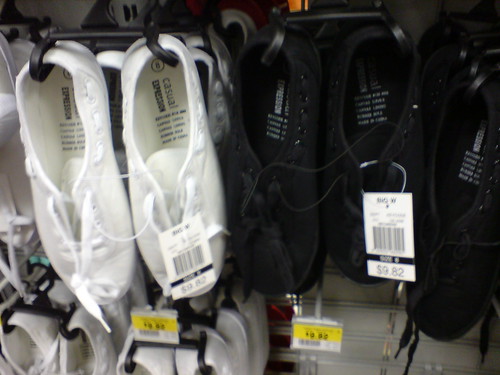
Here are the ones at Big W. They're $9.82, and I thought that represented fairly good value. They're the sort with decorative threaded eyelets along the sides. But they're not, in fact, the cheapest plimsolls around. That honour goes to Kmart.
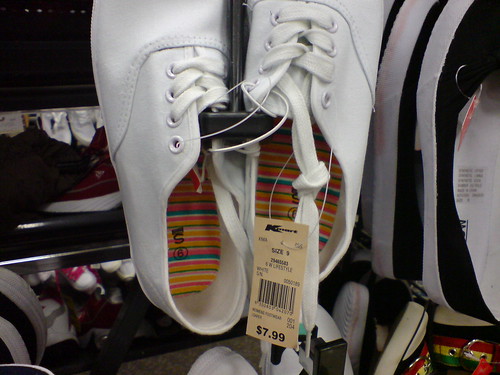
Eight bucks! And check out their range... All this plus white! (The white ones had nearly sold out; only two pairs remaining.)
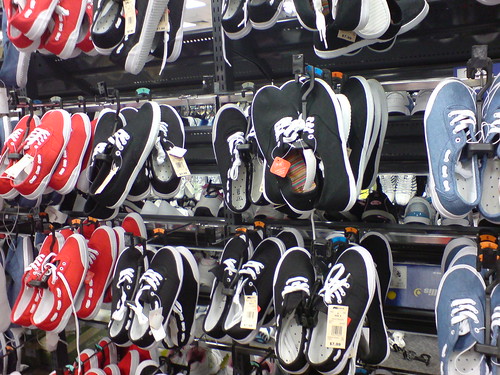
The extreme cheapness and ubiquity of these shoes seem to speak to the mainstreaming of hipsterism I've written about before (and that a commenter on my previous post also mentioned in reference to Australian Idol's Matt Corby). Although last night I learned about an alleged evolution in hipsterism - "new authenticism" - that I found absolutely fascinating and would like to write about at length.
The other interesting thing is that this is quite a genteel preppie look that isn't immediately homologous with the tough-edged '50s-via-'80s pastiche hipsters tend to favour (the high waists; the rolled T-shirt sleeves, the Wayfarer sunglasses). Still, another trend I've observed lately is an old-fashioned casual style - white lace trim on black garments, the return of the tucked-in top - and there is a definite semiotic slippage between toughness and primness - Fred Perry, for example, shifts uncomfortably between being the preppie brand and the bovver-boy brand.